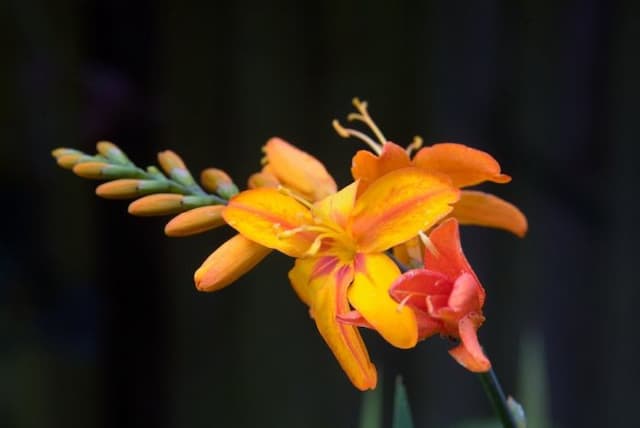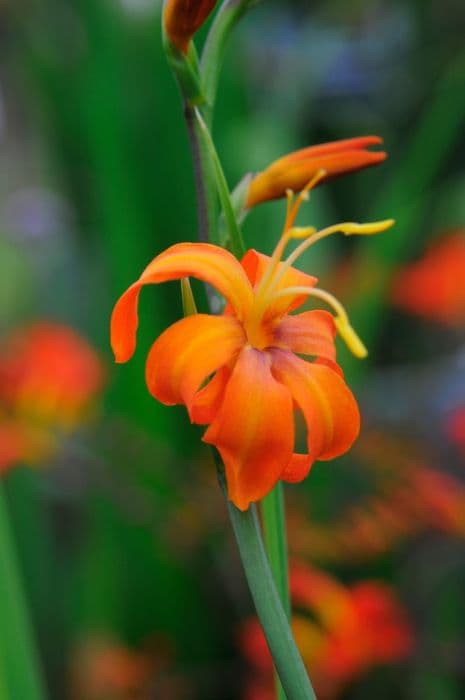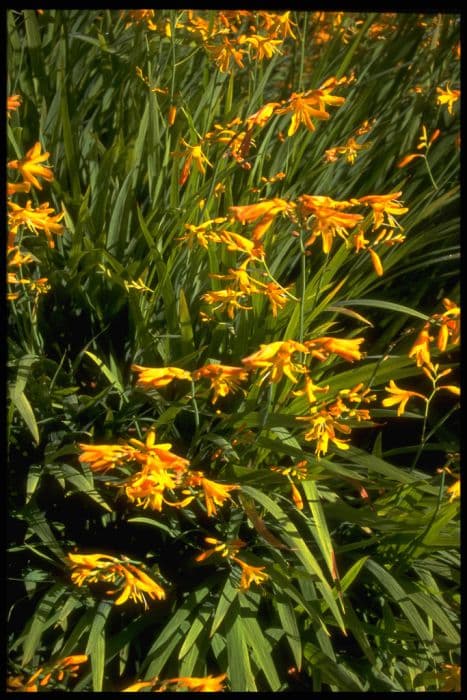Tall Bearded Iris Iris 'Noctambule' (TB)

ABOUT
Iris 'Noctambule' (TB), commonly known as the Tall Bearded Iris, is a perennial plant that is admired for its exquisite and showy flowers. The flowers have an elegant form with large, ruffled petals that are a deep, sumptuous purple, almost black in certain light, giving it a mysterious and dramatic appearance. The standards, or the upright petals of the iris, are beautifully complemented by the falls, which are the downward curving petals. The falls may feature a velvety texture, which adds to the overall luxurious look of the bloom. The beard of the iris, a distinguishing feature found at the top of the falls, is typically a bright and contrasting color, such as golden yellow or white, creating a striking visual appeal against the dark petals. This beard serves as a landing pad for pollinating insects. The foliage of the Tall Bearded Iris 'Noctambule' consists of long, sword-shaped leaves that are a bright, fresh green. These leaves grow in a fan-like fashion and provide an attractive vertical element in the garden setting, contrasting nicely with the flamboyant flowers above. Both the leaves and the stems of the plant contribute to the overall texture and form of the iris, creating a backdrop that highlights the exceptional beauty of the striking blooms that emerge in late spring to early summer. This plant is prized for its ability to add bold color and a refined appearance to garden beds, borders, and cut flower arrangements.
About this plant
 Names
NamesFamily
Iridaceae
Synonyms
Tall Bearded Iris, Noctambule Iris
Common names
Iris 'Noctambule' (TB)
 Toxicity
ToxicityTo humans
The Tall Bearded Iris, including the 'Noctambule' cultivar, is considered mildly toxic if ingested. All parts of the plant, especially the rhizomes (underground stems), contain irritating substances known as irisin, iridin, or irisine. If consumed, symptoms may include stomach pain, nausea, vomiting, and diarrhea. Handling the plant can also cause skin irritation in some individuals. It is important to avoid ingesting any part of the Tall Bearded Iris.
To pets
The Tall Bearded Iris can be toxic to pets if ingested. Like in humans, the rhizomes and other parts of the plant contain compounds that can cause gastrointestinal upset. Symptoms in pets after ingestion may include drooling, vomiting, diarrhea, and abdominal pain. It is advisable to prevent pets from chewing on any part of the Tall Bearded Iris to avoid possible poisoning.
 Characteristics
CharacteristicsLife cycle
Perennials
Foliage type
Deciduous
Color of leaves
Green
Flower color
Purple
Height
2-3 feet [60-90 cm]
Spread
1-2 feet [30-60 cm]
Plant type
Bulb
Hardiness zones
3-9
Native area
Europe
Benefits
 General Benefits
General Benefits- Ornamental Value: The Iris 'Noctambule' is highly prized for its striking deep blue to purple flowers, which add a dramatic flair to any garden.
- Landscape Design: Its tall, elegant stems and bold flowers make it an excellent choice for creating focal points in borders or as part of a floral arrangement in landscape designs.
- Low Maintenance: Iris 'Noctambule' is known for being relatively low maintenance once established, requiring minimal care beyond the basics of watering, occasional feeding, and dividing clumps every few years to maintain vigor.
- Drought Tolerance: Once established, it has good drought tolerance, making it suitable for gardens in drier climates or areas with water use considerations.
- Attracts Pollinators: The flowers of the Iris 'Noctambule' attract pollinators such as bees, butterflies, and hummingbirds, supporting local biodiversity.
- Seasonal Interest: It flowers in late spring to early summer, providing a burst of color when many other plants are still developing.
- Cold Hardy: This plant can withstand cold temperatures and is suitable for growing in a variety of climates, making it accessible to a wide range of gardeners.
- Deer Resistance: Iris plants are generally resistant to deer, which can be particularly beneficial in areas where deer browsing is a common problem for gardeners.
- Easy to Propagate: The rhizomes can be easily divided, allowing gardeners to propagate new plants and expand their garden displays or share with others.
- Versatility: 'Noctambule' can be grown in flower beds, borders, as well as in containers, offering versatility in its use in different garden settings.
 Medical Properties
Medical PropertiesThis plant is not used for medical purposes.
 Air-purifying Qualities
Air-purifying QualitiesThis plant is not specifically known for air purifying qualities.
 Other Uses
Other Uses- Artistic Inspiration: Iris 'Noctambule' can serve as a muse for artists and photographers due to its unique deep color and elegant form, inspiring various forms of artwork and garden photography.
- Educational Tool: Horticulture and botany teachers may use Iris 'Noctambule' as a teaching aid for lessons on plant biology, hybridization, and genetics due to its distinctive traits.
- Theme Gardens: It could be featured as a centerpiece in moonlight or 'white' gardens, where gardeners create spaces that are particularly attractive at dusk or in the light of the moon.
- Eco-Friendly Dye Product: The dark petals of the Iris 'Noctambule' may be used to extract natural dyes for textiles, offering an eco-friendly alternative to synthetic dyes.
- Culinary Garnishing: Although not commonly used for consumption, the petals can add a decorative touch to salads or desserts when ensured they are free of harmful pesticides and other chemicals.
- Floral Arrangements: Its tall and striking silhouette can be used in cut flower arrangements to provide height and a focal point in large displays for events and home decor.
- Perfumery: The scent of the Iris 'Noctambule' isn't commonly extracted, but it could potentially be used in creating bespoke, niche fragrances.
- Living Fences: By planting Iris 'Noctambule' in a row along property lines, it can form a living fence that adds privacy and aesthetic appeal to an outdoor space.
- Wildlife Attraction: The plant can attract pollinators like bees and butterflies, promoting biodiversity and helping to sustain the local ecosystem.
- Symbolism and Gifts: Irises often symbolize hope, faith, and wisdom, making Iris 'Noctambule' an ideal gift for occasions that celebrate these values, such as graduations or personal achievements.
Interesting Facts
 Feng Shui
Feng ShuiThe Iris is not used in Feng Shui practice.
 Zodiac Sign Compitability
Zodiac Sign CompitabilityThe Iris is not used in astrology practice.
 Plant Symbolism
Plant Symbolism- Hope and Optimism: The iris often represents hope, signifying belief in a brighter future.
- Wisdom and Knowledge: Historically, irises were associated with royalty and the divine, often linked to wisdom.
- Courage and Bravery: Its striking appearance can symbolize boldness and courage in the face of adversity.
- Purity and Innocence: The iris’s beauty is sometimes connected with purity and the innocence of the heavens.
- Royalty and Majesty: In some contexts, the iris is associated with royalty and has been used to symbolize regal presence and majesty.
 Water
WaterTall Bearded Irises, such as 'Noctambule', should be watered deeply to encourage deep root growth. Initially, after planting, water them well every few days to help the roots get established, which usually means giving about a gallon of water per plant. Once established, they are drought-tolerant and require watering every two to three weeks if there is no significant rainfall, applying approximately a gallon per plant each time. During hot, dry spells, they may need weekly watering to prevent stress. Always avoid watering the foliage directly to minimize the risk of fungal diseases, and water in the morning to ensure any splash on the leaves can dry out over the course of the day.
 Light
LightTall Bearded Irises like 'Noctambule' thrive in full sun conditions. They need at least six to eight hours of direct sunlight each day to bloom well. Choose a spot in your garden where the plant will receive uninterrupted sunlight for the majority of the day. If the climate is extremely hot, a location with some afternoon shade will help protect the blooms from excessive heat.
 Temperature
TemperatureTall Bearded Irises prefer moderate climates and grow best in temperatures between 35 to 75 degrees Fahrenheit. They can survive temperatures as low as 10 degrees Fahrenheit in winter and as high as 90 degrees Fahrenheit in summer, but prolonged exposure outside these ranges can be harmful. For optimal growth and bloom, maintaining a temperature around the ideal range is recommended.
 Pruning
PruningTall Bearded Irises such as 'Noctambule' should be pruned to improve air circulation, reduce disease risk, and remove spent blooms and foliage. Deadhead the individual spent flowers regularly and cut back the entire flowering stalk down to the base after all the buds have opened and faded. Perform more extensive pruning and division every three to five years in late summer to rejuvenate the plants and to maintain their vigor.
 Cleaning
CleaningAs needed
 Soil
SoilThe Tall Bearded Iris 'Noctambule' thrives in well-draining, slightly acidic to neutral PH soil, ideally between 6.8 and 7.0. A mix rich in organic matter but with good drainage is key. Amending garden soil with compost and coarse sand can create an optimal environment for this iris.
 Repotting
RepottingBearded Irises like 'Noctambule' do not grow in traditional pots and rarely require repotting. Instead, they are divided every 3 to 5 years in late summer to maintain vigor and flower production.
 Humidity & Misting
Humidity & MistingThe Bearded Iris 'Noctambule' is tolerant of a wide range of humidity conditions and does not require any special humidity considerations. It thrives in the average atmospheric humidity found in most temperate climates.
 Suitable locations
Suitable locationsIndoor
Ensure bright light, cool temps, and pots with drainage holes.
Outdoor
Plant in full sun, well-drained soil, divide every 3-5 years.
Hardiness zone
3-9 USDA
 Life cycle
Life cycleThe life of the 'Noctambule' Tall Bearded Iris begins with seed germination, typically after a period of cold stratification which mimics winter conditions. After germination, the seedlings develop into small plants with sword-like leaves and a rhizome from which future growth will occur. As the iris matures, it enters a vegetative stage where it focuses on leaf production and root establishment, usually requiring a season or two before blooming. The reproductive stage follows, with the iris producing distinctive purple to near-black flowers typically in late spring or early summer. After flowering, the iris sets seed while the foliage continues to photosynthesize and store energy in the rhizome for the next cycle. The iris may enter a period of dormancy in late summer or fall, during which the above-ground foliage dies back, and the rhizome rests until conditions are favorable for the next cycle of growth.
 Propogation
PropogationPropogation time
Late Summer – Early Fall
The most popular method of propagation for the Iris 'Noctambule', commonly known as the Tall Bearded Iris, is through division of its rhizomes. This process is ideally done in late summer after the blooming period has ended. Gardeners should carefully dig up the iris clumps and use a sharp knife to cut the rhizomes into sections, making sure that each section has at least one fan of leaves and roots attached. The leaves should be trimmed to a length of about 6 inches (approximately 15 centimeters) to reduce water loss. The divided rhizomes are then replanted at the soil surface with the roots spread out below, spacing them about 12 to 24 inches (30 to 60 centimeters) apart to allow for growth. Adequate watering should follow to help establish the newly planted divisions.
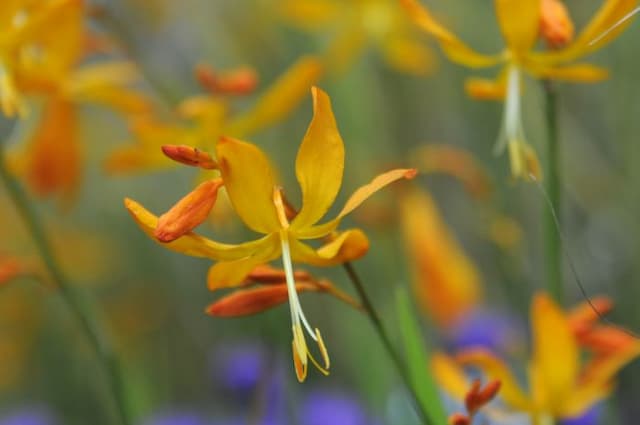
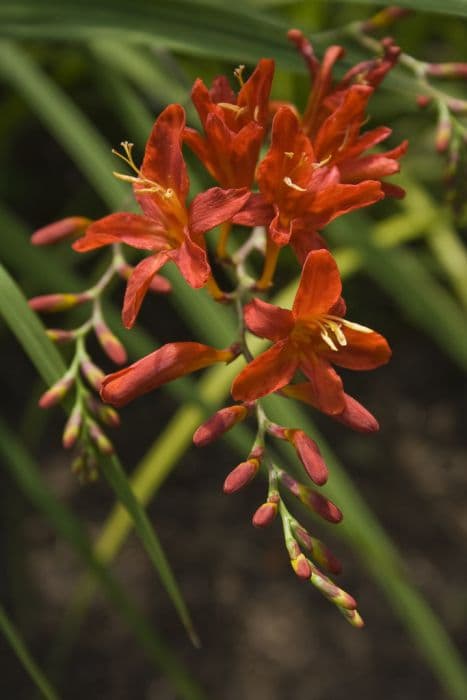
![Montbretia [Bright Eyes]](/_next/image?url=https%3A%2F%2Fplants-admin.emdemapps.com%2Fimages%2Fplants%2F%2Fimages%2F604b5f4a483b6.png&w=640&q=75)
